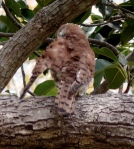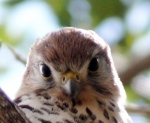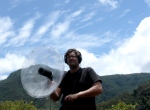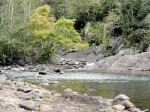Now that I knew exactly where I could find a kestrel, I decided that the best plan of action was to camp out in the forest above his nest. I figured two days would be enough to accumulate a decent amount of recordings.
The hike up to the nest was much more difficult than the previous ascent. The temperature was soaring past 30 degrees C and I was this time, carrying more gear and three liters of water. Eventually, I reached the summit and dropped my pack. After equipping myself with the recording gear, I scrambled the 400 yards or so along the cliff face to the kestrel’s nest. When I arrived, I searched the nearby tree branches for my friend, but he was absent. I figured he was probably hunting and would eventually return. In the meantime, I decided to have a peek into the nest to see if his search for a mate had been realized.
As I was glancing into the empty nest, I felt that strange sensation when you know someone else is nearby without having heard or seen them approach. I turned around slowly and, sure enough, there he was about eight feet away on a low tree branch. It was startling to see him sitting there. In fact, I would say it scared the hell out me and I jumped back a bit. The Mauritius kestrel is not a big bird, I’d say about the size of blue jay, but they have this particular way of glaring over that small and deadly curved beak. It’s very unsettling when they apply that gaze in your direction. I decided that maybe I should back away from the nest. Slowly. I’m also pretty sure that if the bird could speak English, he would have spoken those exact sentiments to me. As I made my way back to the ground, he apparently decided that he had had enough of this giant nest-raiding mammal and flew off his perch directly at me. He was aiming for my face but I managed to turn my head away. I’d like to think that I was fast enough to prevent a direct talon to eyeball meeting, but I’m pretty sure that if he had wanted to, he could have done me a fair amount of damage. No, this flyby was only a warning.
After I had made it back to the ground and moved about twenty feet away, I readied my gear and prepared myself for the long hours of recording to come.
Pointing the microphone at the bird with the device recording, I waited for him to make a sound, but he was apparently not in the mood and just sat quietly on the branch. After a while, it was evident that he was getting used to me. He began preening his feathers and stretching his wings in an effort to get comfortable. In fact, it looked as if he was having a hard time staying awake. As I kept the machine recording trying to figure out what his next move was going to be, I realized that I had made a mistake. From behind me, I heard the telltale shrieking of an approaching kestrel. I quickly pointed the parabola in the direction of the noise and spotted the bird moving rapidly towards me.
It came swooping in and alighted next to my dive-bombing friend with a large lizard in its talons. The two birds began to chatter and chirp to each other and finally, the second bird relinquished the lizard to the original bird and flew away. So, my friend had found a mate after all and this is whom I had been watching all along. Watching her eat her hand-delivered lunch, I couldn’t help but feel a small rush of excitement. The male/female ratio of kestrels on this side of the island is not as balanced as it is on the eastern side. Many of the population go through the breeding season without finding a mate due to a lack of females in the area. And I must admit that I felt a bit proud of my little buddy as well. She was a beautiful bird.
He also had his work cut out for him. During the breeding season, the male kestrel spends a majority of his time hunting for prey (typically small lizards and mammals) and bringing them to the female who perches near the nest and tries to conserve energy in anticipation of the egg-bearing process. I sat the rest of the day and watched as the male would return time after time (averaging about 45 minutes per round), with a meal for his beloved. She would sit and preen herself each time waiting for his return.
And, of course, there was the large mammal with the parabolic disc in his hand sitting and watching the whole process from below. After several hours I had accumulated a fair number of good recordings and had also affectionately named the birds “Archie” and “Edith”. Edith was, by now, comfortable with me and probably assumed that her warning flight had done its trick.
“You stay there and leave my nest alone, I’ll sit here and try to stay awake and everything will be fine between us”, I could hear her thinking.
The pattern soon became evident and the three of us would each perform our individual roles. After securing some prey, Archie would return to the nest. During his approach, he would shriek to let Edith know he was coming. With my recorder constantly running, I would perk up at the sound of his call, locate his position, aim the parabola, and follow him in. He would then land next to her and they would chirp and chatter amongst themselves, the trade off would occur, and then Archie would take flight to search for more food. Sometimes she would eat the meal right there on the branch and other times, if the catch was particularly large, she would jump to the ground (preferably a good distance away from me) to polish it off. I was thoroughly enjoying myself and didn’t notice that it was getting late and I needed to find a suitable campsite. I packed up my gear and headed for my hidden backpack at the top of the cliff.
I located a nice spot overlooking the valley, laid out my bivy and began cooking some noodles. It was about 5:30 and as I sat there I watched dozens of ring-necked parakeets fly up into the valley shrieking their particular brand of vocalization. I saw a giant fruit bat, the size of a large crow, fly past me headed for the forest. White-tailed tropicbirds soared above me in majestic spirals. The crepuscular species began to come alive around me and my instinct was to grab my microphone and begin recording. But I had to resist, as I had used a fair amount of battery life during the day and needed all that I had to fulfill my kestrel commitment. I made a mental note to come back to this spot on a different occasion to record the parrots and the bats and the tropicbirds and the day turning into the night. It took me a long time to fall asleep. My work with the field recorder has changed my way of thinking. I hear the noises around me differently now and my mind cannot help but try to define the species and determine if the parameters are sufficient for recording it. I listened to the geckos and the bats flying overhead and, at one point, heard the snuffling sound of what may have been a tenrec rooting through the leaves and soil nearby. I finally did fall asleep, although it’s difficult to distinguish awake from asleep in a place like this.










